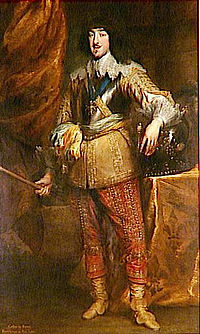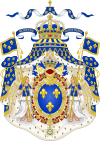- Gaston, Duke of Orléans
-
Gaston of France Duke of Orléans 
Gaston in 1634 Spouse Marie de Bourbon
Marguerite de LorraineIssue Anne Marie Louise, Duchess of Montpensier
Marguerite Louise, Grand Duchess of Tuscany
Élisabeth, Duchess of Guise
Françoise Madeleine, Duchess of Savoy
Jean Gaston, Duke of Valois
Marie Anne, Mademoiselle de ChartresFull name Gaston Jean Baptiste de France House House of Bourbon Father Henry IV of France Mother Marie de' Medici Born 25 April 1608
Palace of Fontainebleau, FranceDied 2 February 1660 (aged 51)
Château de Blois, FranceBurial Basilica of St Denis, France Gaston of France, (French: Gaston Jean-Baptiste de France[1][2]; 25 April 1608 – 2 February 1660), also known as Gaston d'Orléans, was the third son of King Henry IV of France and his wife Marie de Medici. As a son of the king, he was born a Fils de France. He later acquired the title Duke of Orléans, by which he was generally known during his adulthood. As the eldest surviving brother of King Louis XIII, he was known at court by the traditional honorific Monsieur.
Contents
Early life
Gaston de France was born at the Palace of Fontainebleau on 4 April 1608 and at birth was given the title of duc d'Anjou. In 1626, at the time of his marriage to the young Marie de Bourbon, Duchess of Montpensier, he received in appanage (with their respective titles) the duchies of Orléans[2] and Chartres, and the county of Blois.[3] He had nominal command of the army which besieged La Rochelle in 1628,[4][5] having already entered upon a course of political intrigue that would occupy the remainder of his life. He was the heir presumptive to the throne of France from the death of his brother Nicolas Henri in 1611 until the birth of his elder brother's first son in 1638.
On two occasions, he had to leave France for conspiring against the government of his mother and her Prime Minister Cardinal Richelieu. After waging an unsuccessful war in Languedoc leading to the Battle of Castelnaudary in 1632, he took refuge in Flanders. Reconciled with his brother Louis XIII, he plotted against Richelieu in 1635, fled from the country again, and then submitted to the king and the cardinal.
Soon afterwards, the same process repeated itself. Orléans conspired with the marquis de Cinq-Mars to attempt Richelieu's assassination, and then deserted his unfortunate accomplice (1642). In 1643, upon the death of Louis XIII, Gaston became Lieutenant-General of the Kingdom, and fought against Spain on the northern frontiers of France. He was created duc d'Alençon in 1646. During the wars of the Fronde (1648–1653), he demonstrated no particular loyalty to the crown and passed with great facility from one side to the other.
Marriages
Gaston first married on 6 August 1626, at Nantes to Marie de Bourbon, Duchess of Montpensier,[6] daughter and heiress of Henri de Bourbon, Duke of Montpensier. Nine months later, a daughter, Anne Marie Louise d'Orléans, Duchess of Montpensier (1627–1693), Mademoiselle de Montpensier, the future Grande Mademoiselle, was born to the couple. Marie de Bourbon died six days after giving birth, leaving her daughter the last of the line of the House of Bourbon-Montpensier.
Elopement
While taking refuge from the wrath of Cardinal Richelieu in Lorraine, Gaston fell in love at first sight with Marguerite of Lorraine, the sister of Charles IV, Duke of Lorraine.[7] But as France and Lorraine were then enemies, he was refused the king's permission to marry with a sister of its duke. Nonetheless, Gaston fled again to Lorraine and, in a secret ceremony in the presence of her family at Nancy during the night of 2 – 3 January 1632, Gaston took the princess Marguerite as his wife.[7] Because he had not obtained the prior permission of his elder brother, the king — one of his many acts of defiance — the couple could not appear at the French court and the marriage was kept secret.
But in November of that year, Henri II, Duke of Montmorency, on his way to the scaffold, betrayed Gaston, his former co-conspirator, and Louis XIII and Richelieu learned of the elopement.[7] The king had his brother's marriage declared null and void by the Parlement of Paris in September 1634 and, despite the protest of Pope Urban VIII,[8] the Assembly of the French clergy held in September 1635 that a prince du sang could enter matrimony only with permission of the king — consistent with French sovereignty and custom.[7] Although Marguerite and Gaston had re-celebrated their marriage before the Archbishop of Malines, a French emissary persuaded the pope not to protest the matter publicly, and Gaston formally accepted the nullity of his marriage.[7] It was not until Louis XIII was on his death bed in May 1643 that he accepted his brother's plea for forgiveness and authorized his marriage to Marguerite, whereupon the couple undertook nuptials for the third time in July 1643 before the Archbishop of Paris at Meudon, and the Duke and Duchess of Orléans were finally received at court.[7]
By right of her marriage, Marguerite became known as Madame at court. After the death of his mother in 1642, Gaston was bequeathed the Luxembourg Palace, which became the couple's Parisian residence under the name Palais Orléans once they were restored to royal favor. They also sojourned at the Château de Blois, in the Loire Valley, where their first child was born in 1645.
Marguerite and Gaston d'Orléans had five children, three of whom survived into adulthood:
- Marguerite Louise d'Orléans (28 July 1645 – 17 September 1721),
- married in Florence on 20 June 1661 Cosimo III de' Medici, Grand Duke of Tuscany (separated 1675);
- Élisabeth Marguerite d'Orléans (26 December 1646 – 17 March 1696),
- married at Saint-Germain-en-Laye on 15 May 1667 Louis Joseph de Lorraine, duc de Guise;
- Françoise Madeleine d'Orléans (13 October 1648 – 14 January 1664),
- married her cousin Duke Charles Emmanuel II of Savoy, on 4 March 1663, no issue;
- Jean Gaston d'Orléans (Paris, 17 August 1650 – Paris, 10 August 1652), duc de Valois.
- Marie Anne d'Orléans (Paris, 9 November 1652 – Blois, 17 August 1656), Mademoiselle de Chartres.
Gaston had an illegitimate daughter by Marie Porcher:
- Marie bâtarde d'Orléans 1 January 1631, Paris.
He also had an illegitimate son by Louise-Roger de La Marbelière:
- Jean Louis bâtard d'Orléans, comte de Charny, (1638, Tours-1692, Spain).
Later life
After the death of his brother Louis XIII in 1643, Gaston's nephew Philippe became the new Monsieur. To differentiate the older Monsieur from the younger, Gaston, the uncle, was called Le Grand Monsieur and Philippe, his nephew and brother of the new king Louis XIV, was called Le Petit Monsieur.
After the Fronde, Gaston was exiled by Mazarin to Blois in 1652, and remained there until his death. At that time, all of his Orléans titles went to his nephew, now the only Monsieur.
Ancestors
Gaston's ancestors in three generations Gaston, Duke of Orléans Father:
Henry IV of FrancePaternal Grandfather:
Antoine of NavarrePaternal Great-grandfather:
Charles de Bourbon, Duke of VendômePaternal Great-grandmother:
Françoise d'AlençonPaternal Grandmother:
Jeanne III of NavarrePaternal Great-grandfather:
Henry II of NavarrePaternal Great-grandmother:
Marguerite de NavarreMother:
Marie de' MediciMaternal Grandfather:
Francesco I de' Medici, Grand Duke of TuscanyMaternal Great-grandfather:
Cosimo I de' Medici, Grand Duke of TuscanyMaternal Great-grandmother:
Eleonora di ToledoMaternal Grandmother:
Johanna of AustriaMaternal Great-grandfather:
Ferdinand I, Holy Roman EmperorMaternal Great-grandmother:
Anna of Bohemia and HungarySee also
- Charles de Lorme, personal medical doctor to Gaston
References
- ^ Diderot & d'Alembert Encyclopédie méthodique, Paris, 1786, p. 159
- ^ Moote, A. Lloyd, "Louis XIII, The Just", P192. Published 1991, University of California Press. ISBN 0-520-06485-2
- ^ Pitts, Vincent Joseph, La Grande Mademoiselle at the Court of France: 1627-1693, JHU Press, 2000, p. 3, ISBN 0801864666
- ^ Patmore, Katherine, The Court of Louis XIII, Methuen & Co, 1909, p. 144.
- ^ Chisolm, Hugh, Encyclopedia Britannica, Published 1911, p. 284.
- ^ Pitts, Vincent Joseph, La Grande Mademoiselle at the Court of France, p. 2
- ^ a b c d e f Velde, François, Heraldica.org, Morganatic and Secret Marriages in the French Royal Family, Royal Consent: the case of Gaston d'Orléans, retrieved 27 February 2010
- ^ Campagnes de Charles IV, duc de Lorraine et de Bar, en Allemagne, en Lorraine et en Franche-Comté, 1634-1638, d'après des documents inédits, par F. des Robert, Paris, Nancy, 1883, p. 336.[1]
- Gaston Jean Baptiste de France Duc d'Orléans
- Gaston, Duc d'Orléans Accessed February 24, 2008
 This article incorporates text from a publication now in the public domain: Chisholm, Hugh, ed (1911). Encyclopædia Britannica (11th ed.). Cambridge University Press.
This article incorporates text from a publication now in the public domain: Chisholm, Hugh, ed (1911). Encyclopædia Britannica (11th ed.). Cambridge University Press.French royalty Preceded by
Nicolas Henri, Duke of OrléansHeir to the Throne
as Heir presumptive
17 November 1611 — 5 September 1638Succeeded by
Louis, Dauphin of FrancePrinces of France The first generation are the children of Henri IV; these males held the rank of Son of France or Grand son of France;1st Generation 
2nd Generation 3rd Generation Louis, Dauphin of France · Philippe Charles, Duke of Anjou* · Louis François, Duke of Anjou* · Philippe Charles, Duke of Valois* · Alexandre Louis, Duke of Valois* · Philippe, Duke of Orléans4th Generation 5th Generation Louis, Duke of Brittany* · Louis, Duke of Brittany* · Louis XV6th Generation Louis, Dauphin of France · Philippe, Duke of Anjou*7th Generation 8th Generation Louis Joseph, Dauphin of France* · Louis XVII* · Louis Antoine, Duke of Angoulême* · Charles Ferdinand, Duke of Berry*died without surviving issueDukes of Anjou Hereditary Dukes Appanage of Anjou Louise · Alexandre Édouard · Hercule François · Gaston · Philippe · Philippe Charles · Louis François · Philippe · Louis · Philippe · Louis Stanislas Xavier Courtesy title Infante Jamie · Infante Alfonso Carlos · Infante Jaime · Infante Alfonso Currant claimants Charles Philippe · Louis Alphonse Dukes of Orléans Philippe · Louis · Charles · Louis · Henri · Charles · Louis · Charles Maximilian · Alexandre Édouard · Nicolas Henri · Gaston · Philippe · Philippe · Louis · Louis Philippe · Louis Philippe Joseph · Louis Philippe · Ferdinand Philippe · Philippe · François Currant claimants Jacques Categories:- 1608 births
- 1660 deaths
- People from Fontainebleau
- House of Bourbon
- Princes of France (Bourbon)
- Dukes of Valois
- Dukes of Anjou
- Dukes of Orléans
- Burials at the Basilica of St Denis
- Counts of Blois
- Recipients of the Order of the Holy Spirit
- Heirs presumptive to the French throne
- 17th-century French people
- Dukes of Alençon
- Marguerite Louise d'Orléans (28 July 1645 – 17 September 1721),
Wikimedia Foundation. 2010.


